I’ll present in this article 11 symbols of Ganesha, the Hindu God of Wisdom popularly known as the Obstacle Remover. Each of his symbols is related to a powerful symbolism that encompasses his myth and his powers.
Ganesha is one of the most well-known Gods today, even outside of Hinduism. That’s why it’s so important to understand him better through his symbols.
Let’s start?
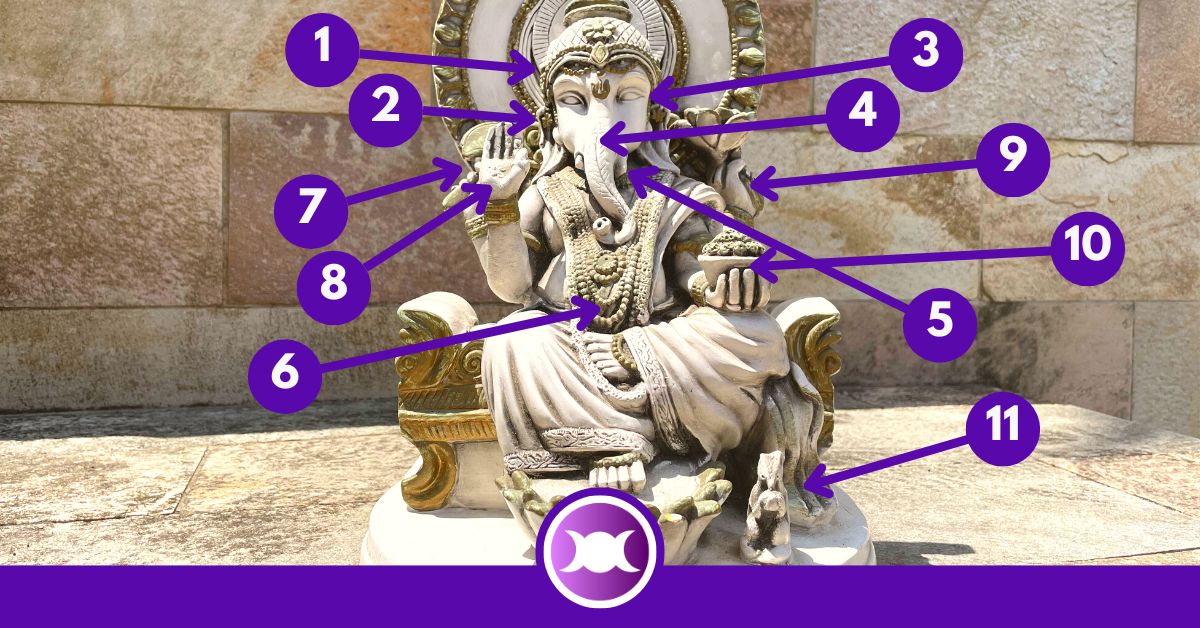
Symbols of Ganesha: Meaning and interpretation
I’ll start now writing about each one of the main symbols of Ganesha. I’m going to present you with the symbol and then I’ll write about its general meaning and interpretation according to Ganesha’s myth. At the end of this article, I’ll show you some book recommendations to understand not only Ganesha but Hindu Mythology and religion.
1) Elephant head
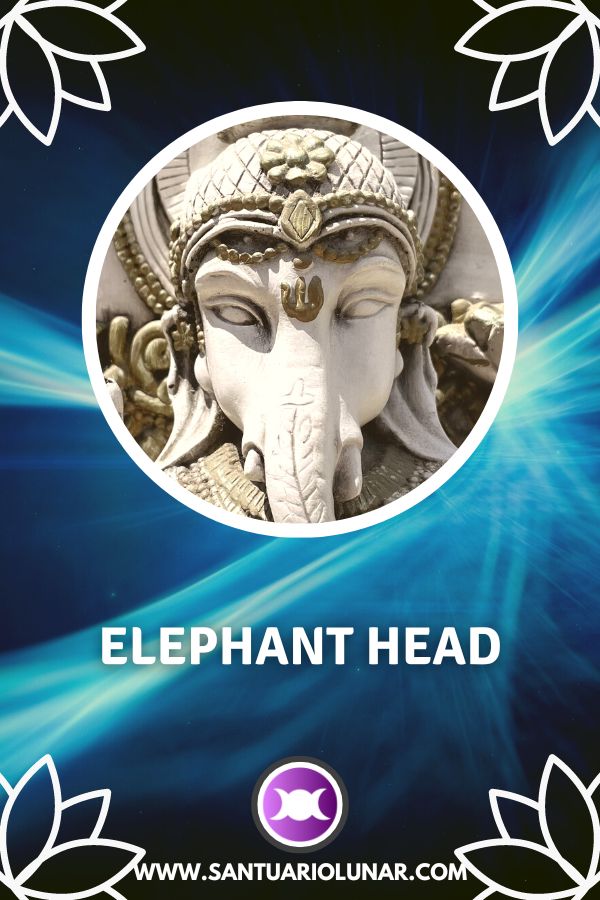
Ganesha’s elephant head is his most iconic symbol. Everybody knows the “Elephant-headed God” in Hinduism. However, not everyone knows the meaning of this symbol. Before I start explaining, I’d like to tell you how he got this elephant head in case you’re not familiar with his story.
In short, his mother Parvati was alone having a bath. She asked him to guard the gates of the palace and forbid anyone from entering. During this period, his father Shiva returned from years of meditation away from home. Shiva and Ganesha didn’t know each other yet!
When Ganesha blocked Shiva’s entrance into his own palace, Shiva got mad and decapitated the kid. Parvati learned about what happened and ordered Shiva to restore Ganesha’s life. To do so, Shiva needed the head of a living animal. When he started hunting, the first animal he found was an elephant. That’s how Ganesha got his elephant head.
Apart from this, the elephant itself holds a powerful symbolism related to wisdom, intellect, and memory. Not simply as a coincidence, Ganesha is regarded as the God of Wisdom and Intellect for the Hindu. Most of Ganesha’s depictions show him with a big head, not so proportional to his body size. Here we have another symbolism. In simple words, we can say: “think big”.
The head of an elephant and the size of his head are one of the most important symbols of Ganesha for they represent pure intellect and the ability to think, analyze, and understand everything.
2) Big ears
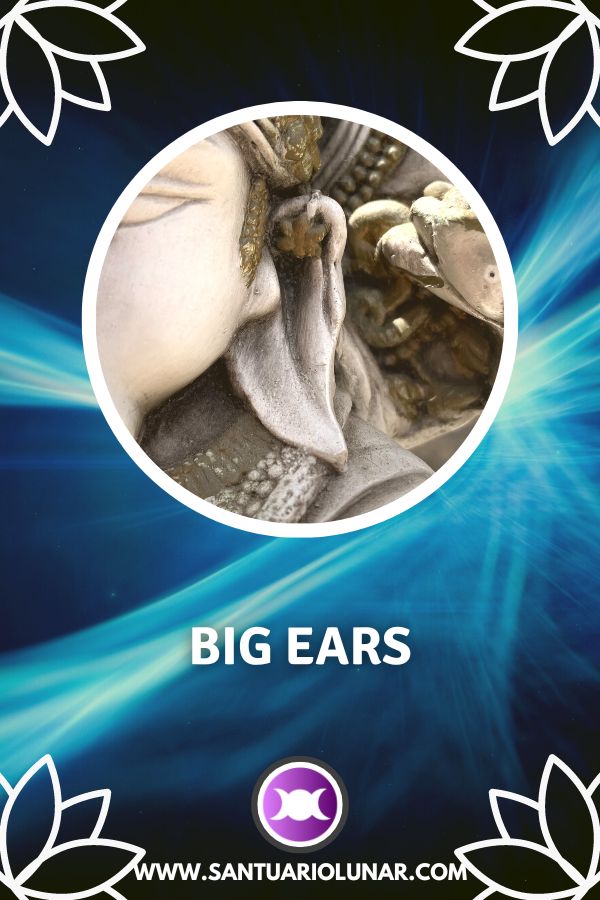
Another striking feature in Ganesha’s imagery is his ears. They are big, just like elephant ears should be. However, there’s more to this here. The symbolism involving Ganesha’s big ears is related to the ability to listen to things, to pay attention to what is necessary, and to understand all the occult or spiritual issues.
Ganesha is portrayed as a guardian in two different stories: in this first, he guards the gates while his mother Parvati bathes. Shiva arrives and decapitates him. In the second story, Ganesha guards the gates while his father Shiva is inside! In this second story, we have another deity who appears and tries to enter the palace: Parashuram, an avatar of Vishnu.
Ganesha forbids Parashunam’s entrance and a battle starts between the two of them. In the end, Parashunam is the embodiment of wisdom and Ganesha learns how to bow in front of wisdom – and absorb it into his life. Parashunam throws an axe toward Ganesha and he remembers the axe was created by Shiva so he allows being hit by it. The axe hits one of Ganesha’s tusks and breaks it. The battle ends and Ganesha becomes wise.
His big ears are used for listening to everything and for learning from everything! He also teaches us to use our ears more often than our mouths.
3) Small eyes

Ganesha is always depicted with small eyes. Have you ever noticed it? If you see the classical depictions of the Hindu Gods and Goddesses, you’ll see their eyes are a bit bigger than usual. It doesn’t happen with Ganesha, though. And why? How small eyes can be one of the symbols of Ganesha?
The answer is simple. His eyes are small because they need to be focused most of the time. A wise person observes everything and learns from everything. When you focus your vision on something, you close your eyes a bit. As if you need to pay more attention to that. Ganesha’s eyes are always paying attention, they are the eyes of truth that are always watching all of us.
More than this, by always having his eyes in “focus mode”, Ganesha is capable of seeing and understanding the duality that exists in the world. It’s said Ganesha is able to walk among all the realities that exist and he can see everything which is in each one of them.
4) Trunk

The trunk is one of the symbols of Ganesha. The trunk is flexible and it can move in all directions as well as grab and hold things. It is also capable of bringing closer what is apparently unreachable by hand. When we see Ganesha’s trunk and its symbolism of it, we understand Lord Ganesha a bit better.
He is capable of moving in any direction he needs or wants, including entering and leaving different realities. Moreover, he can bring anything closer to him so he can understand it better.
Another way to interpret the trunk as a symbol of Ganesha is by observing how elephants use it. They grab food and bring it to their mouth. That’s how they feed themselves. Ganesha doesn’t need his trunk to feed himself. He uses his hands. But with his trunk, he can feed and nourish his soul with intellect.
You may remember this quote by Plato: “knowledge is the food of the soul”. Although Plato can be considered modern compared to Ganesha, the idea of wisdom and intellect is the same.
5) Tusks

The tusks are important symbols of Ganesha. He has two tusks, but one of them is broken. The symbolism of Ganesha lies here too. It’s not broken “by accident”. As far as I know, there are two different stories that depict how Ganesha got one of his tusks broken. I’ve just mentioned above on item 2) Big Ears the first story. According to it, Parashunam wanted to visit Shiva but Ganesha was guarding the gates and forbid him. They fought and Parashunam threw an axe toward Ganesha. Ganesha allows the axe to hit him, as an act of accepting knowledge, once the axe was made by his father Shiva. At this moment one of his tusks was broken.
According to this first story, by allowing the axe to hit him, Ganesha showed he was ready to learn things and bow to wisdom. His broken tusk is a reminder that he must always trust in knowledge. In another way to interpret it, this symbolizes the ability to sacrifice the self in order to acquire new knowledge.
The second story involves Ganesha, a rat, a snake, and the moon. This may be the most popular one. A common feature among many Hindu Deities in Hindu Mythology is that they have a mount. And this mount is an animal. Each Deity has a different one and they are all related to the Deity’s symbolism. In Ganesha’s case, his mount is a rat (See symbol 11).
As the story goes, Ganesha was riding his rat and carrying his Modakapatra (See symbol 10) full of his favorite sweets. At a specific moment, a snake appears in front of them and the rat gets really scared, stopping his movement abruptly. Ganesha falls to the ground, drops all his sweets, and explodes! His belly was full of sweets, so they go all over the place. It’s a tragic moment, however, the moon was watching this scene and started laughing at Ganesha.
Ganesha, without the rat, lost control of his emotions and got angry at the moon. He grabbed the snake and closed his belly. Then, he broke one of his tusks and threw it at the moon, permanently damaging it. After this, the Moon rarely gets complete in the sky and it’s always full of marks on its surface.
Ganesha learned a special lesson in this story. He learned to control his anger and his emotions. A wise person never allows feelings to overcome reason. In other words, the broken tusk is a reminder never to lose reason again.
Others may interpret the two tusks together as a symbolic representation of the duality. One tusk is complete and the other is broken. As a symbol of Ganesha, this represents light and dark, the spiritual and the material worlds, the positive and the negative energies, and so on.
6) Big belly

Have you ever thought a big belly could be a symbol for Ganesha? Yes! His big belly is not big out of the blue, there is a meaning to it. It means Ganesha is capable of devouring wisdom and also capable of digesting it, filtering what’s good and evil. Others may interpret his large belly as a symbol of contentment, abundance, and prosperity.
It’s interesting this relationship between Ganesha and prosperity and abundance. As I mentioned before, Ganesha is mainly known as a God of Wisdom and pure intellect. However, there’s a lot more related to him. There’s a story in which Lakshmi, the Hindu Goddess of Beauty and Riches, felt incomplete. Parvati, Ganesha’s mother, suggested Lakshmi should have a child.
For whatever reason, Lakshmi and Vishnu never conceived a child together. But Lakshmi heard Parvati’s words and felt inclined to, so she asked Parvati to lend one of her boys: Ganesha (God of Wisdom) or Kartikeya (God of War). Parvati carefully thought about the situation and decided to lend Ganesha to Lakshmi.
Because of this, it’s very common to see representations of Lakshmi and Ganesha side by side. Prosperity met wisdom. Riches met the intellect. Only good things can happen when you’re wise and prosperous.
Ganesha’s big belly symbolizes these good things in life and also his ability to eat and filter knowledge.
7) An Ankusha (or a Small Axe)
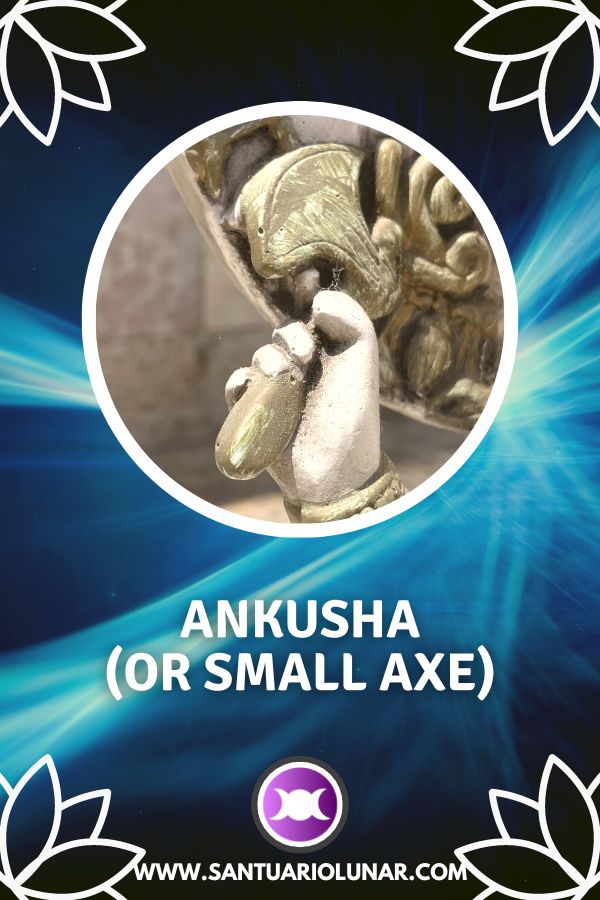
The ankusha is a prominent symbol of Ganesha. It is an elephant goad, a tool used to train and guide elephants. It’s also popularly replaced by a small axe. This tool was largely used to guide elephant herds and guide them into the right path or direction.
In Ganesha’s right upper hand, the ankusha, or the small axe, has can be interpreted in two ways.
The first one is about the ankusha and it is related to guidance. The ability to walk on the right path along a dangerous journey. The journey towards wisdom is always dangerous for there is much false knowledge all along the way. Whenever we start this journey, we must be aware of this and learn how to filter what’s good and what’s dangerous for our minds. We must guide ourselves away from ignorance.
The other meaning is about the small axe and is related to its ability to cut things. Using this small axe, Ganesha can cut the bonds that tie us to the material world and release our bodies and minds from attachments. It’s usually difficult to let things go in our reality. When we start walking the path of enlightenment, we need to detach from material things. If there’s a line connecting us to these things, this symbol of Ganesha can help us to cut it and be free.
8) The right bottom hand
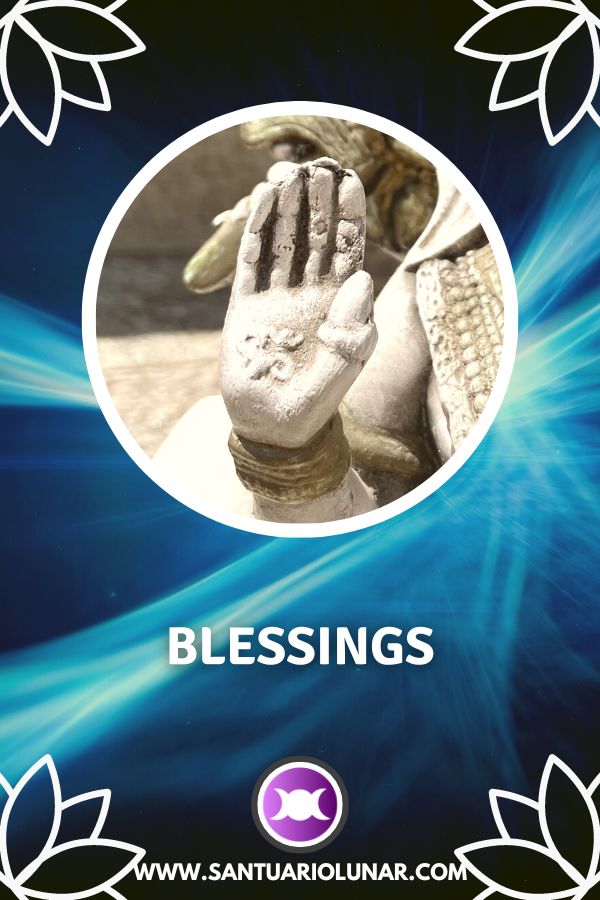
Ganesha’s right bottom hand symbolizes blessings. This hand can have the Om symbol on it or not. Sometimes he’s even holding something like his broken tusk or a sweet, for example.
This symbol of Ganesha means he’s always blessings whoever asks for his advice or guidance. More than simply blessing, Ganesha also protects everyone during this journey and guides them toward spiritual enlightenment. His blessings and protection come as love, prosperity, and knowledge.
9) Rope

The rope is also a symbol for Ganesha. In this case, the rope can be interpreted as a rope itself or as a noose. In the image above from my statue of Lord Ganesha, we can see the rope together with a Lotus Flower. This is common in many depictions of him.
As a rope, this symbolizes Ganesha’s ability to unite things that must be united by nature. For example, you and your goals in life must be apart for some reason. Ganesha can help you to get closer to your goals by pulling them to you with his rope. Besides shortening the distance, the rope also serves as a bond between you and them.
Now, as a noose, this symbol of Ganesha is related to his ability to capture all the obstacles and difficulties around you. By doing this, all these difficulties are lessened and the obstacles are removed (more on this below).
Trivia: The rope is also a symbol of Hecate
10) Modakapatra (A Bowl Full of Sweets)

The bowl of sweets, sometimes a bowl of rice, is another very common and important symbol of Ganesha. This bowl with food holds everything that Ganesha loves eating! It symbolizes the rewards we find not only at the end of the path but along it. Walking the path of wisdom with Ganesha is not something hard that will make you suffer. Quite the opposite! It’s an enlightening path full of wisdom, graces, and blessings.
When we see any image of Ganesha holding his bowl of sweets, we know that he’s enjoying what he has. So must we! This symbol is a powerful reminder that we must enjoy the moments and be happy with who we are.
11) Rat (His mount)
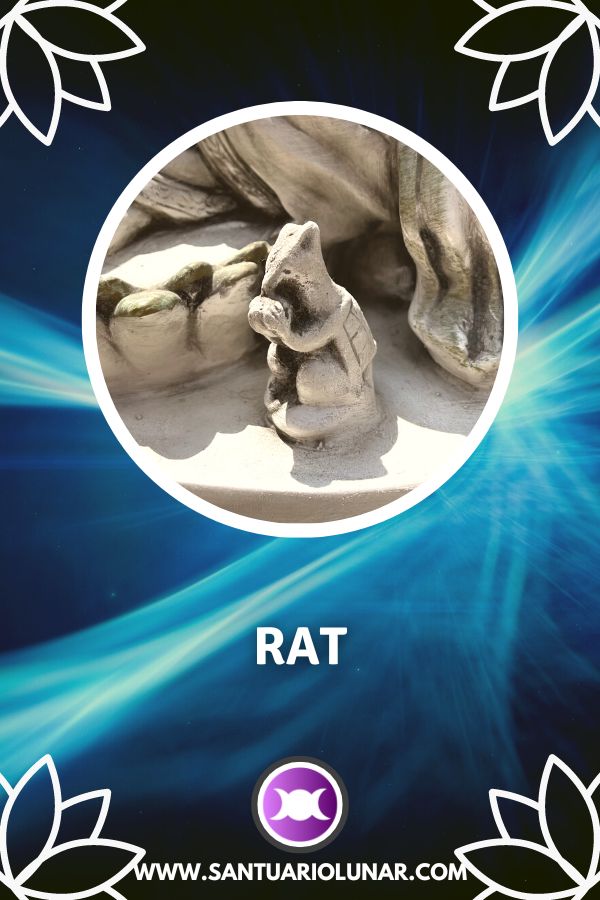
The last symbol of Ganesha I’ll write about is the rat. I left the rat to the end because it’s a rather complex symbol. Firstly, as I mentioned in symbol 5 Tusks, it’s common to see Hindu Deities with an animal as a mount. Ganesha’s mount is a rat. In this sense, the rat represents emotions and our deepest feelings.
When Ganesha rides a rat, he controls his emotions and he is always placing reason over them. In that story I mentioned, the rat got scared by a snake and dropped Ganesha on the floor. This symbolizes a moment when Ganesha lost control over his mind and became angered. When he saw the moon laughing at him, he even broke one of his tusks and threw it at her!
Can you see how bad it is when we lose control of our feelings?
His broken tusk is there so he’ll always remember to keep his emotions under control.
Now the other meaning. The rat is capable of creating paths in places where it seems to be impossible. It can gnaw it through! When Ganesha rides on it he fully controls it (his emotions). This is how he can remove every single obstacle on the way. We can even consider the rat as one of the most important symbols of Ganesha!
As the obstacle remover, Ganesha riding a rat teaches and shows us we must always control our feelings and emotions. This is the way we can increase our knowledge, avoid problems, lessen difficulties, and ultimately have all obstacles removed towards our enlightenment.
Conclusion and book recommendations
So these are 11 symbols of Ganesha. By understanding each one of them we can understand Lord Ganesha better too! There can be many other symbols related to him too but these ones are more than enough to establish a rewarding connection with him.
If you could choose one symbol for Ganesha to carry with you, which one would it be?
Feel free to tell me the answer in the comments.
Save the image below to your Pinterest folders!
Below you can find some book recommendations that will help you to understand more Ganesha, Hindu Deities, and other aspects of their culture, religion, and mythology.
- Classical Hindu Mythology: A Reader in the Sanskrit Puranas
- Ganesh: Removing the Obstacles (Minibook)
- Namaha, Stories From The Land Of Gods And Goddesses: Illustrated Book
Thanks.
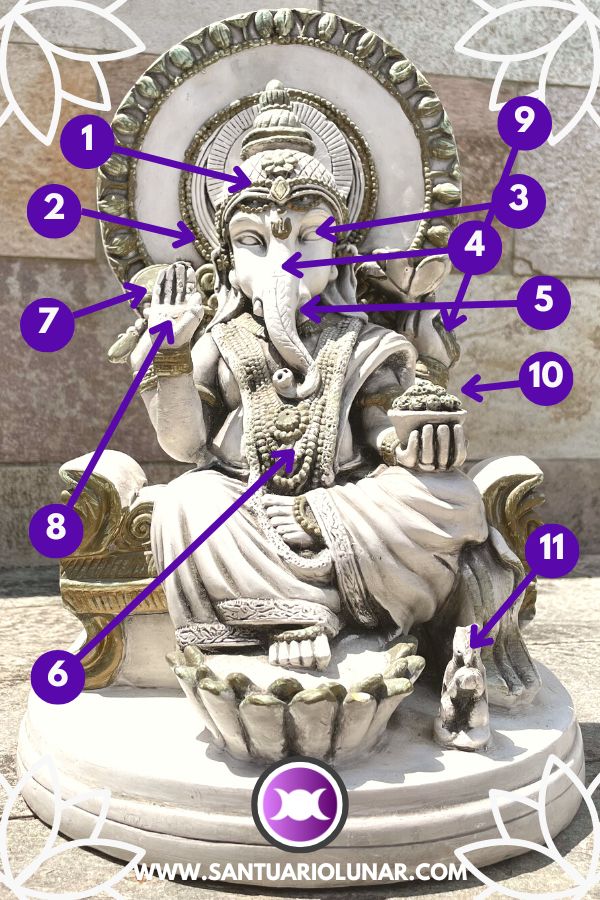


4 thoughts on “11 Symbols of Ganesha: Powerful symbolism of this Hindu God”